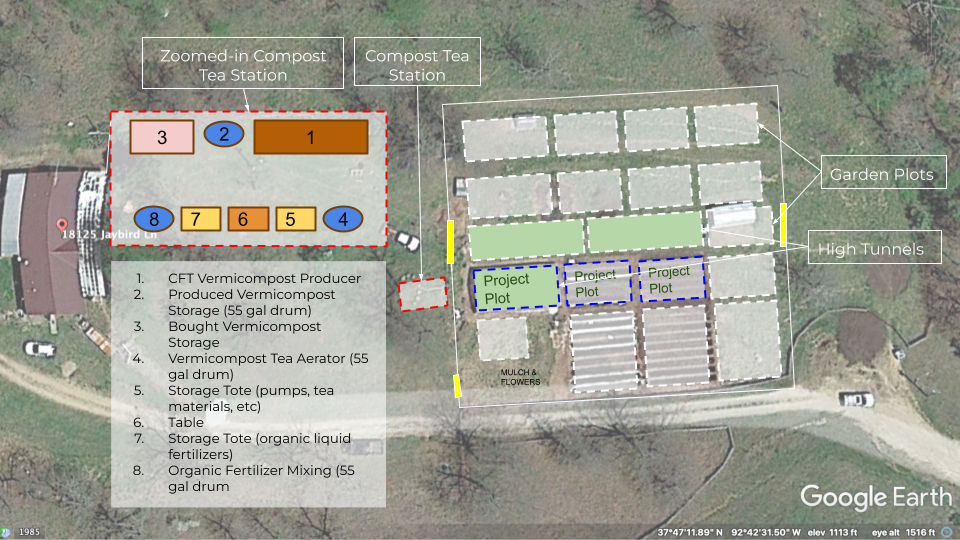Project Overview
Commodities
Practices
Proposal summary:
Many market garden farmers
growing vegetables in our region are not taking advantage of the
environmental, economic and human health benefits resulting from
the use of natural / organic liquid fertilizers made on their own
farms, such as vermicompost teas. As demonstrated by past SARE
funded projects and a growing number of organic farming
literature, safe, agriculturally effective and ecologically
sustainable vermicompost and vermicompost teas are easy to
produce and use on farms at various scales. Their use sustains
healthy plant growth and yields highly nutrient rich vegetables
and fruits that attract premium prices in the market, while also
improving the soil. Farmers that do not produce and use
vermicompost and vermicompost teas on their farms are missing out
on short and long term cost savings and resilience in the face of
growing costs of fertilizers and the maintenance of productive
agricultural soils, as well as on capturing higher prices on
healthier, more abundant and nutrient rich produce. Low adoption
rates in our region of on-farm vermicompost and vermicompost tea
production and use may be due tue a lack of accessible and well
documented resources that depict the advantages and details of
this practice in market gardens in our region.
Project objectives from proposal:
Solution:
The Vermicompost and Vermicompost Tea Production
Station
In a designated space in the
vicinity of our existing ¾ acre market garden, we will build a
mobile vermicompost production and liquid fertilizer making
station. This station will be scaled to primarily serve the needs
of this project, (production and demonstration purposes). The
station will be a 16x24x9 high tunnel customized with
environmental controls, including roll up sides, fans, a covering
tarp and insect protection mesh. Inside, the station will contain
the following:
-
a custom built 10’x3’continuous
flow-through (cft) vermicompost production bin with 50 pound
maximum production capacity -
3 55 gallon plastic drums with
lids for storing the harvested vermicompost, for “brewing the
aerated teas and mixing the organic liquid
fertilizers, -
4 different plastic toast with
wheels to store the materials and equipment used in the
project -
An area to store the
commercially bought vermicompost
This is where the on-farm
vermicompost will be produced, the 2 aerated teas will be brewed,
(one from the vermicompost produced on the farm and one
with the commercially bought vermicompost), and the organic
liquid fertilizers will be mixed for regular soil drenches. All
the materials, supplies and equipment for this project will be
inside this station.
The trial plots
For this project we will use 3
similar test plots in our existing garden, one for each liquid
fertilizer, growing the same plants at the same time. We will
designate three (3) 30”x30’ rows per test plot, for a total of 9
rows. We will test carrots followed by beans and lettuce followed
by peppers in the field and radishes followed by tomatoes in a
high tunnel. Every row will have the same initial treatment: 2 to
3 inches of commercially bought organic compost.
The Operations
We will feed and harvest from the
cft once per week. The feedstock will include mostly food and
weed free garden waste as well as manure composted over 150F to
make sure seeds are killed and avoid germination in our plots.
The cft will be kept at SARE funded literature suggested
temperature and humidity ranges and protected from insects,
especially flies.
We will make and apply the liquid
fertilizers every 2 weeks as a soil drench/soak with a watering
can on each row. We will stop fertilizing leafy and root crops at
least 1 week before their harvest date and fruiting crops
after peak production (mid/late august).
We will use best literature
suggestions, including SARE funded projects, for aerated tea
“brewing”, organic fertilizer mixing and application quantities
(approx. 20 gallons / acre)
We will document all of our
actions and their effects, such as testing the soil ph and
macronutrient contents, as well as biological activity via our
existing microscope, every week. Once harvested, we will also
send samples of the crops for nutrient density
testing.
We will share our findings
publicly once per month via video and blog posts on a project
designated webpage and conduct a hands-on demonstration full day
workshop for the local farmers for 2 years in a row.
Objectives
-
Document the assembly and
operations of a scalable,mobile, continuous flow-through (cft)
vermicompost production bin and vermicompost tea production
station for 2 growing seasons (pictures, videos, guide book
style notes) -
Document and compare the costs,
operations and production effects of the 3 liquid fertilization
sources, including soil biology activity, plant growth rate,
plant health and produce nutrient density. (pictures, videos,
guide book style notes) -
Share the process and findings
online via monthly vlog and blog entries during the 2 growing
seasons -
Share the process and findings
in-person via 1 annual on-farm workshop in 2 growing
seasons
